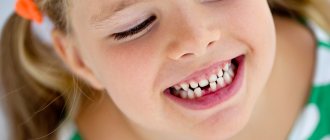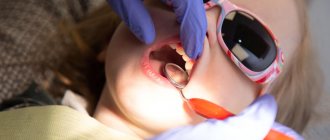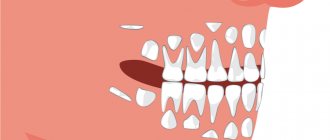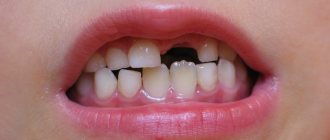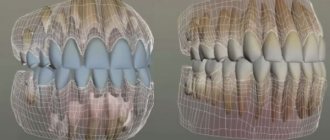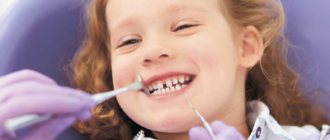Date of publication: 04/04/2016
until February 28
We're giving away RUR 1,000 for all services per visit in February More details All promotions
If a child begins to behave restlessly, sleep poorly at night, sulk and be capricious, this does not always mean that he is sick. Maybe he's just teething.
Erupting teeth irritate the nerve endings in the gums, which explains changes in the baby’s behavior. The child puts everything into his mouth, feeling the need to bite and gnaw - this makes it easier for him to tolerate the itching of the gums. The gums turn red and swell. At this time, saliva is released abundantly; it simply flows from the child’s mouth. In some cases, diarrhea (diarrhea) and fever may occur.
Teething
– a serious event for the body that requires effort. As a result, immunity may decrease, which creates a favorable situation for various infections to enter the body. Therefore, during this period it is especially important to monitor the health of your baby.
Can a baby cut teeth at such an early age?
The average time for teeth to appear in infants is 6–8 months. The first to grow are the two lower central incisors, which usually erupt one after the other. But you should understand that the time frame is not limited. Sometimes the process may take some time. There are cases when the first incisors appear earlier. Therefore, when asked whether teeth can be cut at two months, experts answer in the affirmative. A deviation of the time frame by several months in both directions is considered normal. Only if a one-year-old child does not have a single tooth should you consult a doctor.
Each organism is individual, so some babies already have their first tooth at 2–3 months. The process is determined not only by genetics, but also by a number of other factors:
- climatic conditions;
- maternal nutrition;
- features of the course of pregnancy;
- disruptions of the endocrine system - sometimes the early appearance of teeth may indicate its abnormalities.
If during pregnancy the mother took multivitamins or additional mineral complexes containing vitamins D and C, then the timing of teething may accelerate. A woman’s consumption of fermented milk products in large quantities also contributes to this.
Which baby teeth do children cut first?
Typically, the lower primary teeth erupt first, followed by the upper pair of antagonists. The first teeth always grow in twos, with a slight time difference.
So which tooth comes in first? First, 2 central lower incisors appear, then 2 central upper ones. Following them, the lateral incisors are cut in a similar sequence - first the lower, then the upper.
Then the lower pair of first molars erupt through a short space from the lateral incisors. A similar picture is observed from above. After some time, a pair of fangs will grow in this gap. The formation of a temporary occlusion ends with the appearance of second molars, which also erupt first from below and then from above.
Dentists and pediatricians allow some deviations in the order of eruption, designating this as a variant of the individual norm.
What are the symptoms of teething
Only some parents do not encounter difficulties with their child’s teething and notice the incisor by chance, not understanding when it appeared. In most cases, the process is accompanied by unpleasant symptoms:
- Swelling, “looseness” of the gums. Redness and bumps may form. Sometimes the teeth show through the gums. In some cases, there are bluish hematomas.
- Increased salivation. This may cause rashes around the mouth. But salivation at 2 months of age does not always indicate teething. During this period, such a process is physiological. If the rashes appear in other places, this is not related to teething.
- Restless state. The child cries a lot, is capricious, and the quality of his sleep deteriorates. Often the baby cannot be calmed down. Conventional methods (swinging, pacifiers, etc.) do not help.
- Increased body temperature. More often these are indicators up to 37.5 ˚C. This can happen due to local inflammation (of the gums). A higher temperature indicates viral activity.
- Loss of appetite. During the period of teething, children eat poorly or refuse to eat at all. Sometimes the baby cannot be put to the breast. Some babies kick their legs and arch when feeding.
- Runny nose and cough. Due to increased salivation, mucus flows down the back of the throat. It gets into the nasal passages, since the baby at the age of two months is more in a lying position. When mucus enters the throat, it provokes a cough. More often it appears during sleep.
Such symptoms do not occur all at once and can be combined in different ways. They often become a serious cause for concern for parents. Even the fact that a child is teething at such an early age is already shocking to them.
It is important not to confuse the signs of infectious or neurological diseases that have similar symptoms with the process of teething. Therefore, it is better to show the baby to the doctor. The following symptoms are also reasons to seek help: the child is very lethargic, has a high temperature (above +38 C), vomiting or mouth ulcers. A child may also vomit due to excessive salivation when mucus enters the stomach. Loose and frequent stools also indicate an infection. Diarrhea can cause dehydration.
What to do if the order and timing of the eruption of baby teeth in children is disrupted?
It is not uncommon for a child to cut his first milk teeth at the age of one year or even later, or, on the contrary, a four-month-old baby can already boast 1-2 incisors. Dentists and pediatricians recommend not to panic and not take any action. Under no circumstances should you start giving your child any medications or vitamins without a doctor’s prescription. The appearance and growth of primary teeth can occur according to an individual schedule, taking into account genetic predisposition.
If the baby is completely healthy, then parents should be patient and just wait. Primary (congenital) adentia is an extremely rare phenomenon. The complete absence of at least one tooth germ is found in less than 0.1% of newborns.
What to do if baby teeth are crooked?
No one can answer the question why children's baby teeth grow incorrectly. In the vast majority of cases, we are talking about hereditary predisposition or intrauterine malformations. In the photos and videos of babies you can see that the problem of crooked first baby teeth is quite common. So what to do in this case? Contact an orthodontist as soon as possible.
To correct malocclusion at a young age, the following are used:
- Vestibular plates of Dr. Hintz;
- Trainers and LM activators;
- Braces.
Often a permanent tooth appears under a baby tooth, breaking the orderly row. In this case, removal is often indicated, however, the final verdict remains only with an orthodontic specialist.
How to help your baby
If a baby starts teething at 2 months, in addition to fatigue due to sleepless nights, parents feel worried about their baby. Since he suffers from pain, discomfort, eats little and sleeps poorly, it is necessary to help relieve unpleasant symptoms. To do this, use the following methods:
- Massage the gums. You must first wash your hands thoroughly. The massage is done with the tip of your finger. It is worth trimming your nails to avoid damaging your gums. Massaging helps relieve pain. The degree of effectiveness of the method can be determined by the child’s reaction.
- Cold is applied. Regular teethers, which are sold in pharmacies and offered to older children, will not be chewed by a baby at the age of two months. In this case, he can cool the pacifier or apply a gauze pad to the problem area. It is pre-moistened with cold water or chamomile infusion, which helps relieve inflammation.
- Lubricate the gums with anesthetic gels. For example, “Kamistad” or “Kalgel” are products that can be used even at an early age.
- They give antipyretic and painkillers based on ibuprofen and paracetamol. Candles are given to 2-month-old babies. This could be, for example, “Efferalgan”.
During the teething period, it is important to provide the baby with proper care. It is necessary to keep the pacifier clean. Saliva should be wiped off only with clean napkins. The skin around the mouth should be lubricated with a special baby cream. You also need to walk more - fresh air will only do you good. But it is better to avoid places with large crowds of people so that the baby does not catch an additional virus.
If a child’s teeth appear early, if he is breastfed, it is worth visiting a dentist. The fact is that the risk of developing bottle caries in this case is quite high.
When do babies get their first teeth?
Undoubtedly, the question at what age children begin to develop their first baby teeth is very important for all parents. It is a kind of measure of the “normality” of the baby and determining the degree of its development. The classic timing for the appearance of a milk bite is as follows:
| Age, month | |
| Lower central incisors | 6-8 |
| Upper central incisors | 7-9 |
| Lower lateral incisors | 7-9 |
| Upper lateral incisors | 8-10 |
| Lower first molars | 12-16 |
| Upper first molars | 13-17 |
| Lower canines | 15-20 |
| Upper canines | 16-20 |
| Lower second molars | 20-30 |
| Upper second molars | 21-30 |
Recently, cases have become more frequent when a baby’s first tooth is cut before the generally accepted period of an average of 4 months. Many cases of babies being born with an erupted tooth have been recorded. Modern pediatricians consider this normal and do not recommend that parents worry about this.
However, parents are much more worried about the late appearance of teeth. The first incisors can appear at 10 months, a year or even later. No one can say in advance how many months a child’s first tooth will erupt. If the baby is healthy, eats well and receives a preventive dose of vitamin D in the autumn-winter period, then late teeth are also an individual version of the norm. By the way, the time of teeth appearance does not affect the “painfulness” of the process. This is another myth that the later the teeth are, the harder it is for the child to bear it.
How long does it take for a baby to cut his first tooth?
From the very moment the baby’s gums swell, and with all his appearance he shows that his first teeth are about to appear, mothers begin to worry about the question, how long does it take for the very first tooth to appear? How long will the child be capricious, hungry and have difficulty sleeping?
Since the schedule for the appearance of baby teeth is individual, the time required for the appearance of one is also difficult to predict. The speed of teething can be affected by the child’s health status, lack of calcium and other factors.
Scheme of eruption of the first milk teeth in children
The timing of the eruption of baby teeth is indicated in the table above, and how they are located in the jaw is shown in the figure.
On average, by the age of one year, a child should have 4-6 milk teeth, ideally 8, however, modern pediatrics and dentistry do not consider it a pathology if a completely healthy child has deviations in one direction or another.
Possible abnormalities in the child
Parents should know when to expect changes in their child's bite . Late change of baby teeth, like premature change, is undesirable. They speak of lateness when an eight-year-old child has not yet lost any of his incisors; they speak of early eruption if a five-year-old child has already lost many of his incisors and fallen out. It is important to find out the cause of the changes occurring and, if possible, eliminate it.
Factors due to which the bite changes earlier than standard periods:
- severe jaw injuries;
- congenital diseases leading to anomalies in the eruption of temporary and permanent units;
- advanced caries, due to which crowns and roots are destroyed faster than necessary.
As for a late shift, it is possible due to:
- rickets, calcium and vitamin D deficiency in the child’s body;
- hereditary characteristics of the dentofacial apparatus;
- some infectious pathologies.
When do baby teeth start falling out?
Baby teeth begin to form while the baby is still in the mother's womb. Moreover, their number is not 32, as in an adult, but only 20. Baby teeth usually fully erupt by the age of 2. At the age of approximately 6 years, the replacement of baby teeth with permanent teeth begins to occur. In this case, 20 existing teeth fall out, and the remaining 12 erupt. This usually happens in the following order:
- The deciduous incisors are usually the first to fall out. The roots of the teeth begin to thin out, and when the baby reaches a certain age, the incisor falls out. For central incisors it is 6 years, for lateral incisors - 7 years.
- Then the molars begin to fall out. These baby teeth are divided into first and second teeth. Loss of first molars occurs between 7 and 10 years of age. The second molars are the last to fall out, between the ages of 9 and 13.
- In the interval between the loss of the first and second molars, loosening and loss of the upper and lower canines occurs. This occurs between the ages of 9 and 11 years.
It should be remembered that the process of replacing baby teeth with molars is individual, and the indicated timing is not necessarily suitable for all children.

